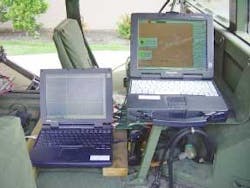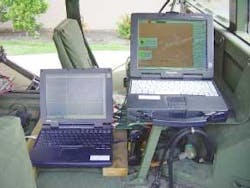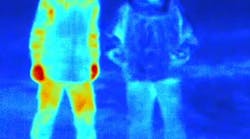FORT MONMOUTH, N.J. - Army tank commanders need a clearer view of the battlefield than they have today, so they can track friendly forces and enemy targets.
To support that effort, Army researchers at the Communications-Electronics Command (CECOM) in Fort Monmouth, N.J., are building a network called Force-21 Battle Command, Brigade and Below, known in shorthand as FBCB2.
The system will build a battlefield intranet using rugged computers linked to satellites, digital radios, and individual soldiers.
The system will support lower-echelon battle command tactical mission requirements, such as real-time situational awareness, target identification, and graphical combat area displays.
Soon, drivers of the M1A2 Abrams main battle tank and M2A3 Bradley Fighting Vehicle will be able to use the system to see a digital map of the battlefield, illustrated with blue icons to represent friendly forces and red icons for the enemy. Then they can trade information, sending text messages to other drivers.
Army and Marine drivers will also use global-positioning-system receivers to convey their location to general officers. Overall, this digital battle command information system will feed information to commanders, leaders, and soldiers, to improve both command and control and situational awareness.
On Oct. 28, Army planners took another step toward developing FBCB2 technology when they announced a $39.5 million contract to buy rugged computers from DRS Technologies Inc. in Parsippany, N.J. DRS had also won a $100 million, five-year, indefinite delivery/indefinite quantity (IDIQ) full-rate production contract in June for the project.
When deployed, the system will use digital information processing and networking to improve combat support, real-time command and control capabilities, enhanced interoperability, and situational awareness.
The situational awareness component will collectively display the geographical location of all weapons, platforms, soldiers, command posts, and other facilities. This will work together with the Army’s Tactical Internet (TI) for ease in communications.
In turn, the TI interfaces with the Army Tactical Command and Controls System (ATCCS), collects information from the operation center and the individual units, and then disseminates it through FBCB2 computers for improved situational awareness.
“These systems have proven to be crucial assets for our forces in Iraq as part of the Army’s network-centric communications infrastructure by providing improved interoperability and networked battlefield command information,” said Steven T. Schorer, president of DRS’s C4I Group. “As the only provider of these next-generation, high-visibility, battlefield command information systems, we are totally committed to our role on the FBCB2 program.”
The company’s Tactical Systems unit in Palm Bay, Fla., will perform the work for these orders, including the design and manufacture of rugged computer hard disk drives and processor, display, and keyboard units. Beginning in 2005, they will deliver more than 4,000 Appliqué Computer Systems.
Many other suppliers have won contracts for FBCB2 - General Dynamics C4 Systems, Scottsdale, Ariz., will provide mobile handheld computers; M-Systems Inc., Sunnyvale, Calif., will provide solid- state memory drives; and Z Microsystems, Inc. in San Diego will provide multiprocessing computers.




